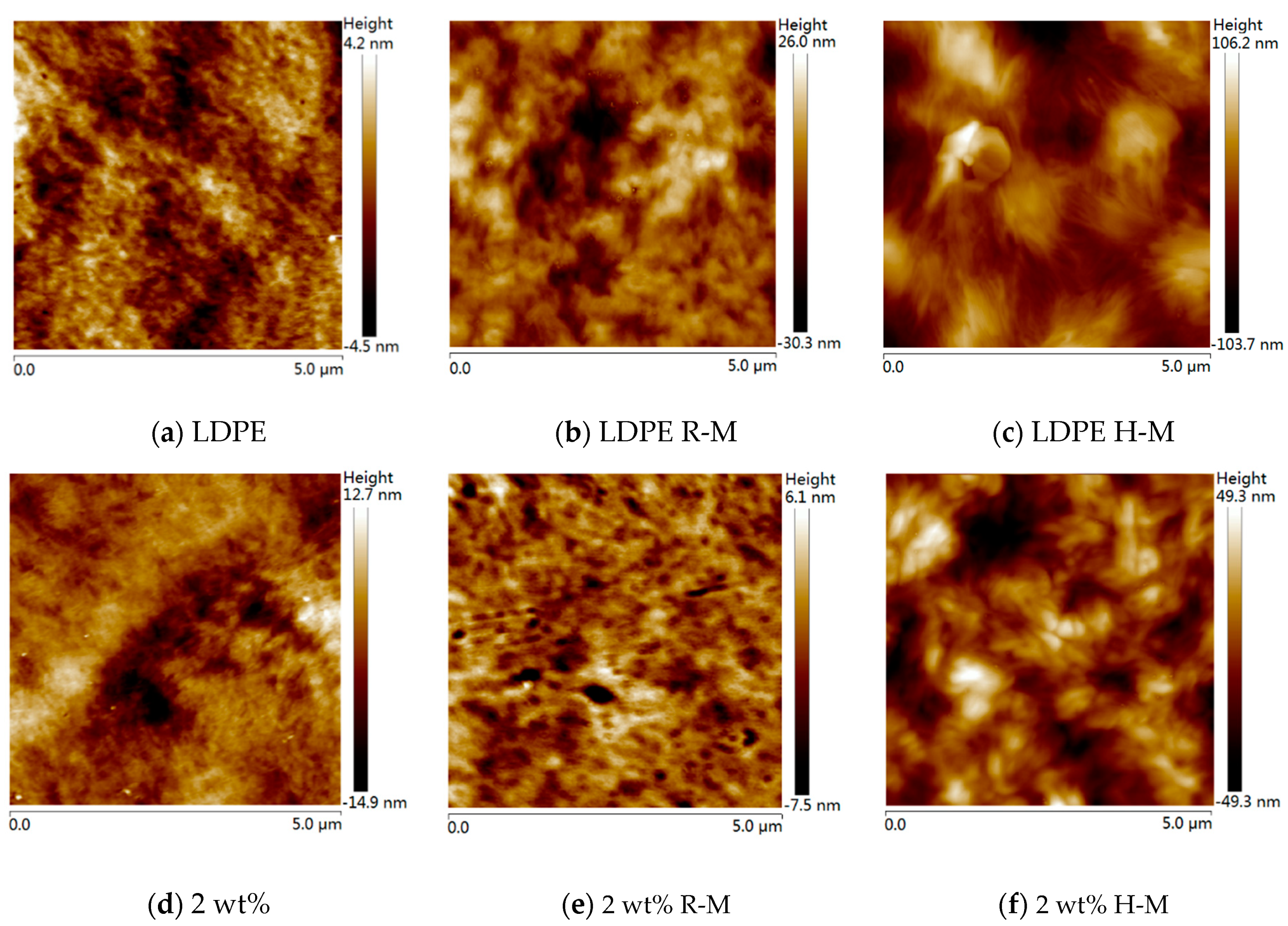Investigation of Electrical Properties of BiFeO3/LDPE Nanocomposite Dielectrics with Magnetization Treatments
Abstract
:1. Introduction
2. Experiments
2.1. Material Synthesis
2.2. Characterization and Testing Methods
3. Results and Discussion
3.1. Molecular Structure Characterization
3.2. Breakdown Field Strength
3.3. Conductance Current Test
3.4. I-t Characteristics
3.5. PEA Space-Charge Test
4. Conclusions
Author Contributions
Funding
Institutional Review Board Statement
Informed Consent Statement
Conflicts of Interest
References
- Plesa, I.; Notingher, P.V.; Stancu, C.; Wiesbrock, F.; Schlogl, S. Polyethylene Nanocomposites for Power Cable Insulations. Polymers 2018, 11, 24. [Google Scholar] [CrossRef] [PubMed] [Green Version]
- Song, W.; Sun, Z.; Zhang, D.; Han, B.; He, L.; Wang, X.; Lei, Q. Synthesis and characterization of low density polyethylene with multiferroic bismuth ferrite nanocomposite. J. Mater. Sci. Mater. Electron. 2015, 27, 2328–2334. [Google Scholar] [CrossRef]
- Song, W.; Wang, X.; Zhang, D.; Sun, Z.; Han, B.; He, L.; Lei, Q. Preparation and characterization of multiferroic material BiFeO3. J. Inorg. Mater. 2012, 27, 1153–1157. [Google Scholar]
- Li, S.T.; Wang, S.H.; Li, J.Y. Research and development progress and path analysis of HVDC cable materials. High Volt. Technol. 2018, 44, 1399–1411. [Google Scholar]
- Wang, W.; Min, D.; Li, S. Understanding the conduction and breakdown properties of polyethylene nanodielectrics: Effect of deep traps. IEEE Trans. Dielectr. Electr. Insul. 2016, 23, 564–572. [Google Scholar] [CrossRef]
- Castellon, J.; Yahyaoui, H.; Guille, O. Dielectric properties of POSS/LDPE and MgO/LDPE nanocomposites compounded by different techniques. In Proceedings of the 2017 IEEE Conference on Electrical Insulation and Dielectric Phenomenon (CEIDP), Fort Worth, TX, USA, 22–25 October 2017; pp. 457–460. [Google Scholar]
- Plesa, I.; Notingher, P.V.; Schlogl, S.; Sumereder, C.; Muhr, M. Properties of Polymer Composites Used in High-Voltage Applications. Polymers 2016, 8, 173. [Google Scholar] [CrossRef]
- Adnan, M.M.; Tveten, E.G.; Glaum, J.; Ese, M.-H.G.; Hvidsten, S.; Glomm, W.; Einarsrud, M.-A. Epoxy-Based Nanocomposites for High-Voltage Insulation: A Review. Adv. Electron. Mater. 2019, 5, 1800505. [Google Scholar] [CrossRef]
- Khomchenko, V.A.; Karpinsky, D.V.; Paixão, J.A. Magnetostructural correlations in BiFeO3-based multiferroics. J. Mater. Chem. C 2017, 5, 3623–3629. [Google Scholar] [CrossRef]
- Li, J.; Tan, G.; Ren, X.; Ao, D.; Liu, C.; Ren, H.; Xia, A.; Liu, W. The enhanced multiferroic properties of BiFeO3 composite film by doping ions in the magnetic layer. J. Mater. Sci. Mater. Electron. 2021, 32, 4639–4650. [Google Scholar] [CrossRef]
- Hou, L.; Shi, L.; Zhao, J.; Zhou, S.; Pan, S.; Yuan, X.; Xin, Y. Room-temperature multiferroicity in CeFeO3 ceramics. J. Alloys Compd. 2019, 797, 363–369. [Google Scholar] [CrossRef]
- Jiang, Y.; Zhang, Z.; Zhou, Z.; Yang, H.; Zhang, Q. Enhanced Dielectric Performance of P(VDF-HFP) Composites with Satellite-Core-Structured Fe2O3@BaTiO3 Nanofillers. Polymers 2019, 11, 1541. [Google Scholar] [CrossRef] [PubMed] [Green Version]
- Lan, W.; Hao, X.; Dou, Y.; Zhou, Z.; Yang, L.; Liu, H.; Li, D.; Dong, Y.; Kong, L.; Zhang, D. Various Structural Types of Cyanide-Bridged Fe(III)-Mn(III) Bimetallic Coordination Polymers (CPs) and Polynuclear Clusters Based-on A New mer-Tricyanoiron(III)Building Block: Synthesis, Crystal Structures, and Magnetic Properties. Polymers 2019, 11, 1585. [Google Scholar] [CrossRef] [PubMed] [Green Version]
- Yu, Z.; Zeng, J.; Kassiba, A.; Zheng, L.; Peng, J.; Li, G. Enhanced electrical properties of BiFeO3–PbTiO3 based ceramics with suitable raw material. J. Mater. Sci. Mater. Electron. 2019, 30, 14500–14507. [Google Scholar] [CrossRef]
- Dubey, A.; Castillo, M.E.; Shvartsman, V.V. Tuning the optical, structural and multiferroic properties of Bismuth Ferrite (BiFeO3) Nanoparticles by Doping with Ba. In Proceedings of the 2019 IEEE International Symposium on Applications of Ferroelectrics (ISAF), Lausanne, Switzerland, 14–19 July 2019; pp. 1–4. [Google Scholar]
- Niu, F.; Gao, T.; Qin, L.; Chen, Z.; Huang, Z.; Zhang, N.; Wang, S.; Sun, X.; Huang, Y. Polyvinyl Alcohol (PVA)-assisted Synthesis of BiFeO3 Nanoparticles for Photo catalytic Applications. J. New Mater. Electrochem. Syst. 2015, 18, 69–73. [Google Scholar] [CrossRef]
- Song, W.; Fan, Y.Z.; Hua, Y.; Sun, W.F. Magnetic and Dielectric Properties of Nano- and Micron-BiFeO3/LDPE Composites with Magnetization Treatments. Materials 2019, 13, 120. [Google Scholar] [CrossRef] [PubMed] [Green Version]
- Xin, M.; Zhang, Y.; Hao, C.; Lei, Q. Influence of nano-doped LDPE cable insulating materials on the insulation and thermal conductivity properties. In Proceedings of the 2016 IEEE International Conference on High Voltage Engineering and Application (ICHVE), Chengdu, China, 19–22 September 2016; pp. 1–3. [Google Scholar]
- Sharma, A.; Tripathi, B.; Vijay, Y.K. Dramatic Improvement in properties of magnetically aligned CNT/polymer nanocomposites. J. Membr. Sci. 2010, 361, 89–95. [Google Scholar] [CrossRef]
- Shorstkii, I. Synthesis of Magnetically Controlled Fe3O4 Composites and Their Enhanced Microwave Absorption Properties. In Proceedings of the 2018 XIV International Scientific-Technical Conference on Actual Problems of Electronics Instrument Engineering (APEIE), Novosibirsk, Russia, 2–6 October 2018; pp. 372–375. [Google Scholar]
- Chi, Q.; Ma, T.; Dong, J.; Cui, Y.; Zhang, Y.; Zhang, C.; Xu, S.; Wang, X.; Lei, Q. Enhanced Thermal Conductivity and Dielectric Properties of Iron Oxide/Polyethylene Nanocomposites Induced by a Magnetic Field. Sci. Rep. 2017, 7, 3072. [Google Scholar] [CrossRef] [PubMed]









| Sample Name | Peak (°C) | Delta H (J/g) | Crystallinity (%) |
|---|---|---|---|
| LDPE LDPE R-M LDPE H-M 2 wt% 2 wt% R-M 2 wt% H-M | 107.55 106.61 107.57 107.20 108.31 107.52 | −108.44 −118.52 −110.01 −110.34 −118.07 −115.54 | 36.93 40.37 37.47 38.18 40.21 39.35 |
Publisher’s Note: MDPI stays neutral with regard to jurisdictional claims in published maps and institutional affiliations. |
© 2021 by the authors. Licensee MDPI, Basel, Switzerland. This article is an open access article distributed under the terms and conditions of the Creative Commons Attribution (CC BY) license (https://creativecommons.org/licenses/by/4.0/).
Share and Cite
Song, W.; Sun, Y.; Yu, T.-J.; Fan, Y.-Z.; Sun, Z.; Han, B. Investigation of Electrical Properties of BiFeO3/LDPE Nanocomposite Dielectrics with Magnetization Treatments. Polymers 2021, 13, 2622. https://doi.org/10.3390/polym13162622
Song W, Sun Y, Yu T-J, Fan Y-Z, Sun Z, Han B. Investigation of Electrical Properties of BiFeO3/LDPE Nanocomposite Dielectrics with Magnetization Treatments. Polymers. 2021; 13(16):2622. https://doi.org/10.3390/polym13162622
Chicago/Turabian StyleSong, Wei, Yu Sun, Tian-Jiao Yu, Yu-Zhang Fan, Zhi Sun, and Bai Han. 2021. "Investigation of Electrical Properties of BiFeO3/LDPE Nanocomposite Dielectrics with Magnetization Treatments" Polymers 13, no. 16: 2622. https://doi.org/10.3390/polym13162622






